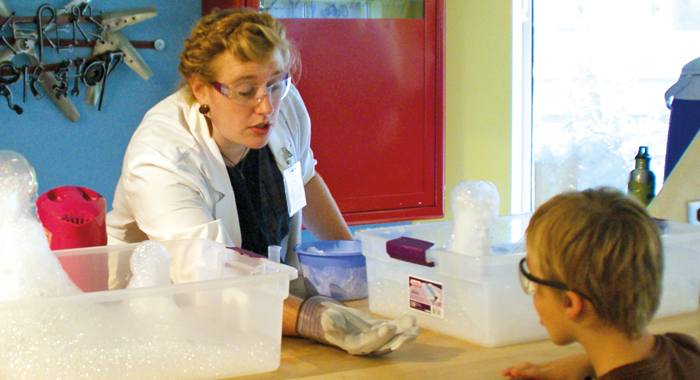Scholarly Journey, Small Detour
Michelle Morrison ’11 never imagined working with children, nor that she would enjoy it so much. Morrison, in fact, had her feet set on a very grown-up educational path.
A double major in anthropology and history, she went on to earn a master’s degree in medieval history at King’s College, University of London, in 2014. She returned home to Madison, Wis., to plan her next step – entering a Ph.D. program. Instead, she is working at the Madison Children’s Museum. She says, “This career path was a complete happy accident. I was looking for something to do and applied for an internship at the museum, since I remembered how much I enjoyed playing there as a child. I was excited when I got it. Then, a few months later I was hired as a program specialist and I haven’t looked back.”
Morrison develops a variety of programs for the museum, including drop-in visits, workshops and adult nights (where adults come to the museum and “play” without the kids). While she would still like to earn her doctorate, she has changed its focus. “I’m hoping to develop free-form programing that I learned so much about here, and translate it to history museums and natural history museums,” she says.
“[At the museum] I develop different programs that complement my interests or touch on themes that are highly valued in the Madison community. We have a popular chemistry program where we do different experiments with the kids.”
Another popular event is the Fractured Fairy Tales program, where Morrison reads a traditional story, but with a twist. “It may be something like ‘Goldilocks and One Bear’ and I try to engage the kids and have them wonder what will happen or what’s different,” she says.
Many programs allow Morrison to educate children and their parents about sustainability. This summer she ran one of the museum’s garden spaces focused on organic heritage farming. Guests help her maintain it. When it comes to history, Morrison takes advantage of the museum’s log-cabin space to teach museum visitors about what life was like in the 1830s. “I had kids help me make pickles out of our bumper crop of cucumbers, just like they did in the 1830s,” she says. “That activity connected with kids on several levels.”
Morrison has had to learn some teaching skills as she went. “I definitely use the research and community outreach skills I learned at St. Norbert in my job,” she says. “I focus on how to take the things I’m excited about, such as history and anthropology, and make them interesting to the kids. I work to have multiple levels to my conversations to include all ages, to make it relatable and still bite-sized, while giving real information,” she says.
She admits she’s not sure what comes next: “I’m looking forward to the next strange twist in my path; I’ve found life’s more fun on the non-traditional routes!”
A little ingenuity can go a long way in keeping children engaged in activities and exhibits, says Michelle Morrison ’11.
“Science and art are really easy to engage kids in, unlike history, anthro-pology, philosophy, sustainability and literature … . Kids like flashier and more exciting things, and I do my best to augment what I know about anthropology and history to make it more approachable, interactive, engaging and fun,” she says.
For example, Morrison invites children to take on the roles of history and anthropology professionals to keep them engaged during her programs. She will also ask them to consider what’s different in their lives and the lives of people from another culture or time period: “It’s easy for kids to understand culture in terms of food, toys, games, clothes and stories. They’re building blocks for discussing how and why humanity has expressed incredible creativity across the globe and across time.”
Nov. 14, 2016












